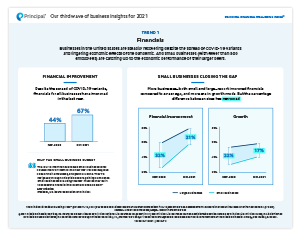Small businesses make financial gains, closing the gap with large businesses

- Despite a competitive labor market, 42% of smaller businesses report increased staff vs 19% in November 2020.
- Gap in financial health between smaller and larger businesses is narrowing, with smaller businesses seeing greater financial improvement.
- 67% of businesses report financial improvement vs. 44% at this time last year.
- For the first time, employers are planning on increasing childcare support as a key employee benefit to attract new employees.
Principal Financial Group® reported today that small and medium-sized businesses (SMBs) are showing stronger current financial health and an increase in hiring, despite the ongoing impacts of COVID-19. At the same time, a shifting environment, lingering economic impacts from the pandemic and increasing employee turnover have made businesses more cautious about their 12-month outlook.
“The last 18-plus months have tested small businesses and caused many to fundamentally change their businesses, find new ways to operate, take care of their employees, and get work done. They’ve navigated through this crisis and are gaining confidence. Small businesses are using the new muscles they built to accelerate financial growth and increase staff in support of that growth,” says Amy Friedrich, president of U.S. Insurance Solutions at Principal®.

See all the latest infographics from the latest Principal Financial Well-Being IndexSM.
The latest Principal Financial Well-Being IndexSM (WBI), in its eighth year, reveals the gap between smaller and larger businesses is narrowing when it comes to growth and financial improvement. Smaller businesses report greater financial improvement (59%) compared to this time last year (31%); similarly, larger businesses report financial improvement (80%) when compared to last year at this time (63%). Smaller businesses are catching up to the improved economic performance relative to their larger counterparts.
These findings are from the latest WBI pulse survey of 500 employers from companies with two to 10,000 employees and span a diverse array of industries, with more than half of the employers falling within finance/insurance, professional/scientific/technical, construction, manufacturing, and information management industries.
Businesses are cautious about economic outlook
While SMBs feel confident about their current economic security now, their 12-month outlook is less optimistic. Smaller businesses, in particular, are concerned about the year to come. Only 46% of smaller businesses feel confident about their financial situation for the next 12 months, compared to 63% of larger businesses, a gap that has widened to a 17-point difference. As the pandemic continues, businesses are cautious about the future economic outlook as they expect more change to come.
While most businesses included in the survey reported being fully operational (60%), many smaller businesses continue to struggle to move forward with only 55% at full operation compared to 66% of larger businesses. The lingering economic effects of COVID-19, protecting employee health and wage inflation—a new addition to the list—are among the top concerns of SMBs. Other concerns include cost of healthcare, cybersecurity, work-life balance and growing revenue.
"Although businesses are feeling confident today, they continue to work through a more complex economy. Employers are concerned about tougher competition for talent, supply chain shortages and the ongoing impact of COVID-19,” says Friedrich. “The pandemic created a lot of uncertainty especially for smaller businesses, which is lingering on and could again affect future growth. While businesses have gotten better at adjusting to volatility, they know personally how a new wave of economic instability can quickly impact revenue.”
Small businesses have made significant gains in staffing since last year
Businesses continue to show great resilience through the economic recovery. Despite the national competition for labor, smaller businesses’ hiring efforts have surged over the last 12 months. Forty-two percent of smaller businesses are increasing staff, compared with only 19% a year ago. That’s more than double the increase among larger businesses, now at 65% compared with 55% a year ago.
However, while smaller businesses have gained ground in hiring, they are also experiencing an increase in turnover. The survey shows a rise in resignations for smaller companies as employees seek retirement or new opportunities that fit their needs. Sixty-seven percent of employees are voluntarily leaving smaller businesses compared to 61% leaving larger companies. The increase in turnover is creating issues for employers of all sizes as they try to stay sufficiently staffed to support their current operations and future growth.
“We’re seeing evidence of the labor dislocation, especially among smaller businesses. I suspect we’ll continue to see increases in hiring as more become fully operational,” observed Friedrich. “Employees are paying attention to the shift happening and believe they have more options than before. Retention will be more critical now as employers compete for employees.”
Aside from retirement, employees are citing additional childcare and caregiving responsibilities as a major obstacle and a top reason why they’re leaving their current jobs. Additionally, employees are taking advantage of the current environment by changing career paths and relocating to different geographic regions.
Employee benefits focus on changing workforce
Employee benefits continue to play a critical role in recruitment and retention as the national competition for labor ramps up. Training and education benefits jumped to the top of the list for employers who say they want benefits to help retain current employees or to improve the employee experience. Additionally, SMBs identified healthcare as a top benefit to attract new employees; it was also the second most popular for employee retention.
As businesses contend with the staffing shortages and transitions, employee benefits can help employers stand out in the fight for talent by meeting employees’ unique needs. Childcare support was identified as an additional key benefit for employee attraction—the first time it has made an appearance as a tool for employee attraction. Nearly two years into the pandemic, childcare remains an obstacle for many families. Providing support can help individuals reenter or remain in the workforce.
“Employees are seeking jobs that fit their personal needs outside of the office. These needs include opportunities for professional certification and degree programs, support for caregiving responsibilities and mental health support,” says Friedrich. “Matching employee needs with employee benefits is critical in the competition for talent and could help retain current employees.”
Other popular employee benefits included telehealth, whose popularity rose rapidly during COVID-19, mental health and well-being programs, financial wellness programs, employee assistance programs (EAP) and paid family or medical leave.
See all results and insights from the latest Principal Financial Well-Being IndexSM (PDF).
News Release Contact
Benefits and protection
Lauren Peed